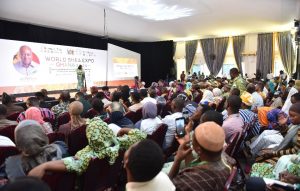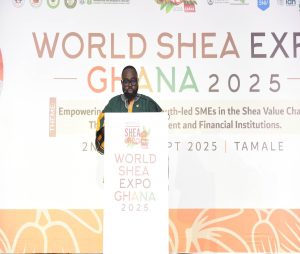Business
Comms and branding with Samuel OWUSU-ADUOMI: Policy, trade and innovation dominate agenda at World Shea Expo 2025
Tamale became the centre of global attention this week as the city hosted the World Shea Expo 2025, drawing more than 8,000 participants from across the shea value chain. Producers, international buyers, policymakers, and development partners converged on the Northern Regional capital from Septem...
B&FT
published: Sep 12, 2025

Tamale became the centre of global attention this week as the city hosted the World Shea Expo 2025, drawing more than 8,000 participants from across the shea value chain.
Producers, international buyers, policymakers, and development partners converged on the Northern Regional capital from September 2 to 4 for what is being described as the most significant gathering of its kind in Ghana.
The Expo underscored the growing importance of shea, long regarded as a subsistence crop for rural women, but now recognized as a strategic economic pillar with billion-dollar potential. Exhibitions, policy discussions, and investment forums highlighted how Ghana aims to shift from being a supplier of raw nuts to a hub for processing, branding, and global trade.

The event was officially opened by the Deputy Chief of Staff, Nana Oye Bampoe Addo, who represented President John Dramani Mahama. In her keynote address, she described the Expo as more than a trade fair, calling it “a vision, a conversation, and a journey to transform the shea sector, ensuring benefits reach every farmer, woman processor, and community.”
With that declaration, Tamale positioned itself not only as the heart of Ghana’s shea belt but also as a stage for international collaboration, innovation, and empowerment in one of Africa’s fastest-growing industries.
The event’s theme, “Empowering Women and Youth-Led SMEs: The Role of Government and Financial Institutions,” captured its essence. By placing women and youth at the center of the agenda, the Expo aligned with Ghana’s broader development ambitions—particularly the government’s 24-hour economy policy—while also responding to global calls for sustainability, inclusiveness, and fair trade.

Nana Oye Bampoe Addo opened the Expo with a keynote address that resonated deeply with participants: “This platform is more than exhibitions and trade—it is a vision, a conversation, and a journey to transform the shea sector, ensuring benefits reach every farmer, woman processor, and community. Today, we open not just an Expo but a gateway to a more prosperous shea industry for Ghana and the world”.
From the outset, it was clear that this was no ordinary gathering. Tamale, with its historic ties to shea production, had become the stage for bold ideas, partnerships and policy commitments that would shape the industry’s future. The following days would blend celebration with hard-nosed discussions on trade, sustainability, and empowerment, leaving behind not only memories but a blueprint for transformation.
Day one – opening ceremony & women in shea
The opening day of the World Shea Expo 2025 set the stage for what would become a defining moment for Ghana’s agricultural and economic landscape. With dignitaries, development partners, and industry actors filling the auditorium of the Modern City Hotel in Tamale, the atmosphere was both ceremonial and purposeful.
Madam Bampoe Addo’s address framed the direction of the Expo. She described the gathering as a global platform not only for trade but also for transformation, urging participants to see the event as “a vision, a conversation, and a journey” that would secure the future of the shea industry.
Her remarks highlighted four key dimensions of the Expo’s significance: visibility, empowerment, partnerships, and sustainability. Ghana, she stressed, must move beyond being a supplier of raw kernels to becoming a hub for value addition. Equally, the Expo was designed to elevate women—the unsung heroines of the shea value chain—while also forging stronger collaborations between governments, private investors, academia, and international markets.
Day One of the Expo highlighted the central role of women, who contribute nearly 90 percent of labor in the shea value chain. A poignant example was shared through the story of Abubakar Barkatu, a mother of seven from the Tungteiya Women’s Shea Butter Association, whose work in processing shea pays for school fees, healthcare, and sustains her household. Her experience mirrored that of over a million women across Ghana’s northern regions, underscoring why shea is rightly called “women’s gold.”
The Women in Shea Panel reinforced this theme, giving cooperative leaders a platform to share experiences and challenges. Panelists stressed the urgent need for greater financial access, improved market linkages, and institutional backing to ensure women not only participate in production but also benefit equitably from the wealth generated globally.
The day ended with the vibrant Shea Trade Fair, where Ghanaian cooperatives, processors, and youth-led enterprises exhibited shea butter, cosmetics, soaps, and food products to a wide range of international buyers. Beyond showcasing creativity and innovation, the fair served as a business hub, forging new networks and partnerships that organizers expect will translate into concrete export deals.
Day two – finance, youth and innovation
The second day of the World Shea Expo 2025 shifted focus from ceremony to substance, bringing money, markets and modernisation firmly to the forefront. While Day One had celebrated the symbolic and social significance of shea, Day Two was about unlocking capital, nurturing entrepreneurship, and introducing innovation into a sector that has long operated on the margins of global trade.
The day began with the Investors Forum, where financiers, development partners, and agribusiness leaders gathered to explore opportunities within Ghana’s shea value chain. At the centre of these discussions was Dr. Peter Boamah Otokunor, Director of the Presidential Initiatives in Agriculture and Agribusiness. In his address on the opening day, he presented an ambitious national vision: “By investing in modern processing facilities, mechanized harvesting, cold storage, and all-season logistics, we are confident Ghana can increase shea nut production to 400,000 metric tonnes annually, valued at US$640 million USD”.

Dr. Otokunor’s remarks were accompanied by a stark reminder of the global context. The shea industry, currently valued at more than $2 billion, is projected to surpass $3 billion by 2030. Ghana, already among the world’s top exporters, has the expertise, the capacity, and the entrepreneurial energy to claim a larger share—if it invests decisively and strategically.
After the Investors Forum, the Youth Entrepreneurship Workshop showcased the energy of young innovators, offering training in processing, branding, and market entry. Start-ups producing shea-based cosmetics and foods pointed to a future of value-added exports. The afternoon’s Sustainability Showcase emphasized climate-smart cultivation, highlighting shea’s role in combating desertification and protecting biodiversity. Day Two closed with clear investment prospects, empowered youth, and a strong narrative of shea as both an economic and environmental asset.
Day three – policy, awards & field visits
The final day of the World Shea Expo 2025 was devoted to charting a long-term roadmap for the industry. Unlike the vibrant opening celebrations or the investment-heavy sessions of Day Two, Day Three carried the weight of policy commitments, institutional reforms, and a deliberate look at the future.
The morning opened with a Policy Dialogue, which gathered government officials, private sector representatives, and development partners around a single table. Discussions focused on strengthening Ghana’s competitiveness in the global shea economy and aligning national efforts with international standards.
Central to these deliberations was the announcement of the revival of the Buipe Shea Processing Factory. Once a neglected industrial asset, the facility has been retooled under the government’s 24-hour economy agenda and is expected to process up to 180,000 metric tonnes annually when fully operational. In addition to providing a ready market for smallholder farmers, the factory is projected to create between 30,000 and 40,000 direct and indirect jobs, particularly for women and youth.
Another policy highlight was the introduction of enforceable national standards for shea kernels and butter, spearheaded by the Tree Crops Development Authority in collaboration with the Ghana Standards Authority and GEPA. These standards, officials stressed, would allow Ghanaian products to access premium markets across Europe, North America, and Asia while protecting consumers and elevating the country’s reputation for quality.
The Deputy Chief of Staff, Hon. Nana Oye Bampoe Addo, reaffirmed government’s commitment to farmer welfare with the introduction of a price floor mechanism for shea, modeled after cocoa, to shield smallholders from market volatility.
The day also featured an Awards Ceremony recognizing cooperatives, processors, exporters, and youth-led enterprises—commendations that not only celebrated excellence but also opened doors to new networks and opportunities.
The Expo closed with Field Visits to processing centers in Northern Ghana, where delegates observed the demanding work of nut collection and processing, alongside the resilience and innovation of local women and youth entrepreneurs.
Day Three ended on a practical and forward-looking note. While the ceremonies and speeches had celebrated progress, the policy dialogue and field visits grounded participants in the realities of the sector—reminding them that the transformation of shea will depend on sustained action long after the Expo’s closing.
Key outcomes and commitments
By the time the curtains came down on the World Shea Expo 2025, the event had produced not just speeches and exhibitions, but concrete outcomes that organizers believe will shape the trajectory of Ghana’s shea industry for years to come.
One of the most immediate gains was the formation of over 150 business-to-business partnerships. These ranged from direct buyer-supplier agreements to joint ventures between local cooperatives and international firms. Many of these partnerships were sealed during the Shea Trade Fair and the Investors Forum, where global buyers expressed strong interest in sourcing not only raw nuts but also processed and branded shea products from Ghana.
The Expo also provided training and capacity-building opportunities for more than 200 SMEs and youth-led businesses, equipping them with knowledge on product development, packaging, market entry strategies, and financial management. Organizers emphasized that these skills are essential if Ghana is to move from being a raw material supplier to a recognized hub for value-added shea exports.
On the policy front, government officials reinforced their commitment to aligning the shea sector with Ghana’s 24-hour economy agenda. The revival of the Buipe Shea Processing Factory was the clearest signal of this intent, backed by promises of job creation and expanded processing capacity. Similarly, the introduction of national quality standards for shea butter and kernels was presented as a decisive step toward strengthening Ghana’s reputation in global markets.
A practical gesture of support came in the form of 20,000 sets of personal protective equipment (PPEs), donated to women shea collectors across the northern regions. Announced by Madam Bampoe Addo, the initiative—backed by the Ghana EXIM Bank, GEPA, and the Directorate of Presidential Initiatives—was designed to enhance safety in the field while improving productivity.
Organizers noted that the move is expected to double recovery rates of shea nuts, significantly increasing yields.

Financial institutions were urged to design flexible products for women’s cooperatives and youth SMEs, while development partners were called to invest in research, innovation, and infrastructure. Traditional leaders were reminded to protect shea landscapes, and the media tasked with telling Ghana’s shea story. Collectively, these commitments signaled a shift from rhetoric to results, positioning the Expo as a working agenda with tangible outcomes for sustainable growth.
The post Comms and branding with Samuel OWUSU-ADUOMI: Policy, trade and innovation dominate agenda at World Shea Expo 2025 appeared first on The Business & Financial Times.
Read More